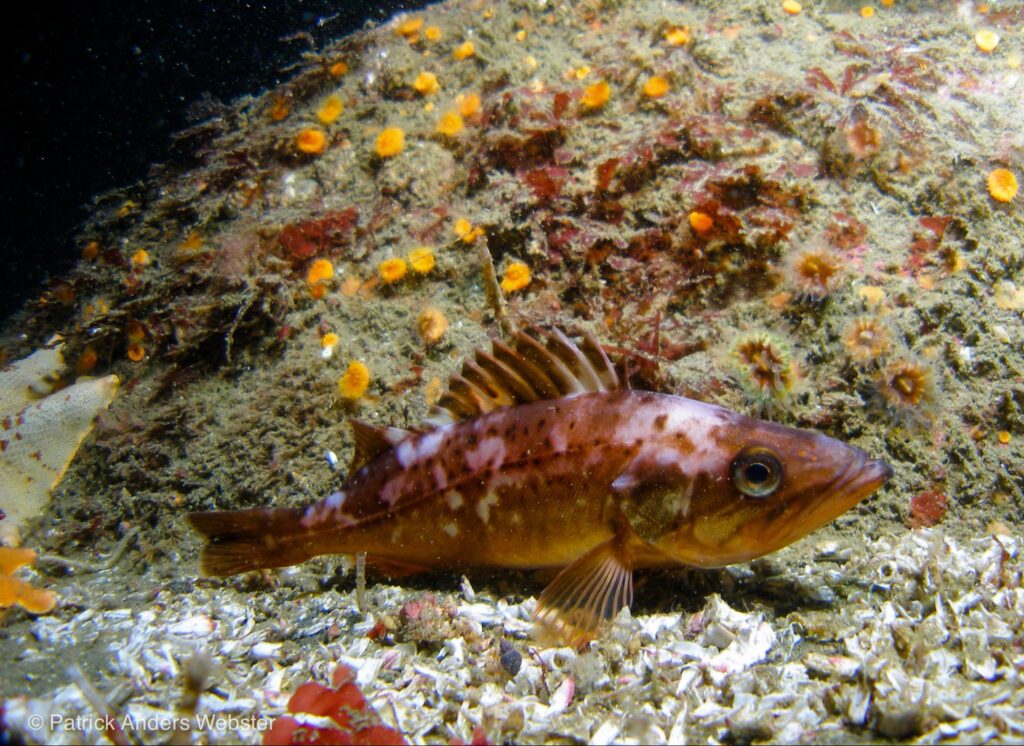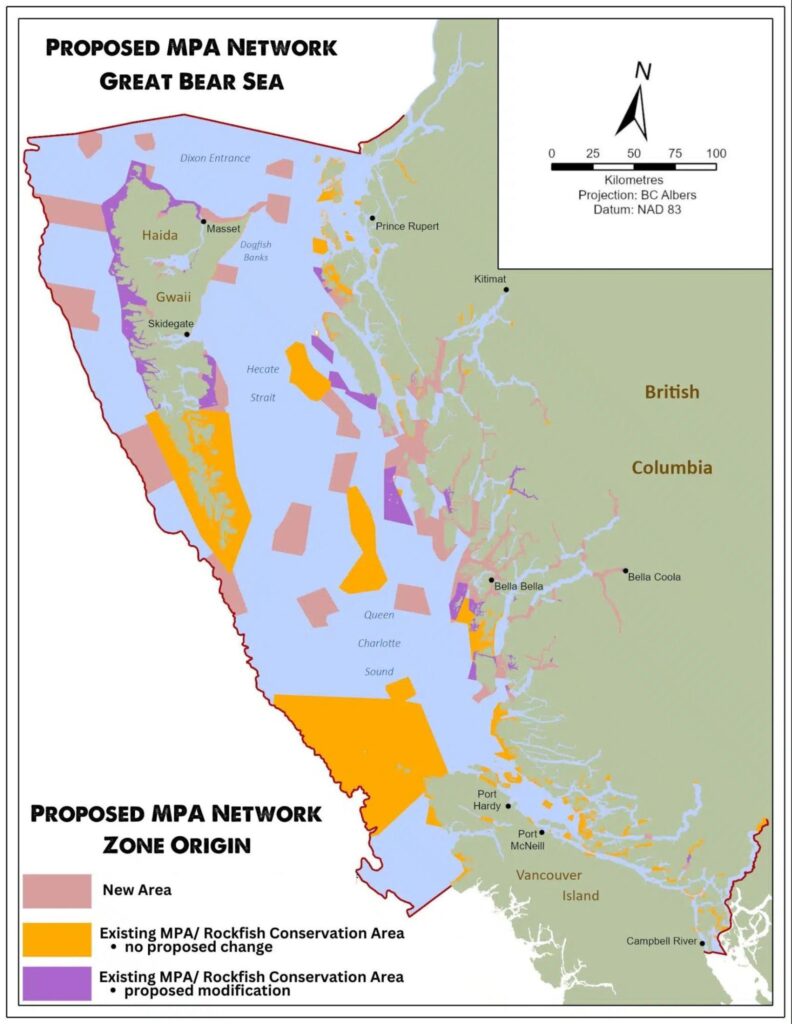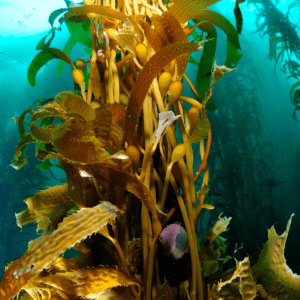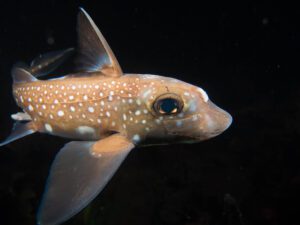In the vast, swirling waters off British Columbia, a story about the urgent need for change is unfolding. This story stars the Bocaccio, a species once abundant in our waters but now considered endangered in BC.

The Bocaccio rockfish (Sebastes paucispinis) distinguishes itself by its impressive lifespan—it is capable of living up to 57 years—and its considerable size, with individuals growing up to a meter long and weighing as much as 10 kilograms. Its long lower jaw sets it apart from other rockfish species, making it easily identifiable. BC’s Bocaccio rockfish are part of a larger family found in the Pacific Ocean from the Gulf of Alaska down to Baja California, Mexico. Yet, the true uniqueness of the Boccaccio lies not just in its physical attributes but in its journey from the nursery of the ocean’s surface to the deep, rocky cradles it calls home as an adult.
From the Surface to the Depths
Off BC’s coast the Bocaccio’s range extends from offshore to the Strait of Georgia, Juan de Fuca Strait, and Queen Charlotte Strait. The species favours rocky bottoms and steep slopes at depths between 60 and 340 metres, where it plays an essential role in the marine ecosystem.

The unique life cycle of Bocaccio rockfish begins in the relative safety of the ocean’s surface layers. Juveniles spend their early life in nursery areas among kelp beds or rocky reefs, environments rich in food sources and shelter. As they mature, they transition to deeper, offshore habitats, from the rocky seafloor to coral and sponge reefs which offer protection and food sources..
The ecological role of the Bocaccio rockfish cannot be overstated. As a predator its diet of smaller fish including anchovies, mackerel, squid and even other rockfish helps regulate the populations of smaller fish and invertebrates, maintaining the health and balance of the ecosystem and commercially important species. Smaller Bocaccio are food for Chinook Salmon, terns and Harbor Seals, while adults are eaten by larger fishes and marine mammals like Harbor Seals and Northern Elephant Seals.
Bocaccio Rockfish: A Vulnerable Existence

Bocaccio rockfish populations have been in a steep decline since the 1950s, including from overfishing. Their population off BC is estimated at merely 3.5% of its level before fishing. The species was recognized as threatened in 2002 and endangered in 2013 by the Committee on the Status of Endangered Wildlife in Canada (COSEWIC).
Though the Bocaccio rockfish is now partially protected in BC the factors that reduced its population so dramatically are still present.Rockfish are still heavily targeted by commercial fishers. Since 2017, both the landed and wholesale value of the groundfish fishery has been in steady decline.
Rockfish are also a popular target of recreational fishers. In the 2021/2022 year, over 300,000 tidal recreational fishing licences were issued in BC. Tidal water recreational licences permit access to all marine species, including many rockfish.

Rockfish is also threatened by trawlers, which scoop them up as bycatch. These rockfish are then tossed back into the ocean, dead. Most have already died a gruesome death by the time they’re hauled up by the nets, caused by barotrauma. Rockfish are bottom dwellers and the rapid ascent causes pressure changes that the fish cannot adapt to. Their bladders expand drastically, pushing their stomachs into their mouths.
On top of that, there have also been instances of illegal rockfish poaching.
These facts give us a clear idea of why the Bocaccio rockfish population has declined so dramatically. If we’re not careful, we could see the same fate for other rockfish species too.
The Path to Recovery for Bocaccio Rockfish
Thankfully, the government recognized the implications of this steep Bocaccio decline and implemented a number of measures to prevent this species. This includes creating conservation areas which fishers must avoid, setting limits for the amount of allowed bycatch, and mandating that fishers donate proceeds from the sale and processing of Bocaccio to conservation efforts.

But are these measures enough? We know that the total number of groundfish vessels continues to be in the 300s, a number that has been mostly consistent since 2011.
This is why the government, along with stakeholders like Indigenous communities and independent fishers, is upping the ante on protections through programs like The Great Bear Marine Protected Area (MPA) Network. One of the key goals of the Great Bear Sea MPA Network is to aid in the recovery of fisheries and ecosystems, including rockfish populations. By managing human activities that are disruptive to marine ecosystems, limiting catches of certain species, and protecting critical habitats where marine life feed, breed, and grow, the network aims to rebuild fish stocks to sustainable levels. This network will cover about 30% of the Great Bear Sea and encompass existing MPAs in the region.

Conclusion
The story of the Bocaccio rockfish in British Columbia is a powerful reminder of the interconnectedness within the marine world. The plight of this rockfish highlights the need for a balanced approach that respects both the ecological significance and the economic value of marine species. Through continued conservation efforts and sustainable practices, there is hope for the Bocaccio rockfish to thrive once again in the Pacific waters of BC.




